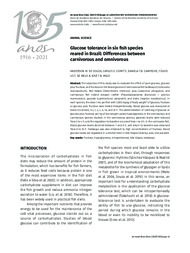Glucose tolerance in six fish species reared in Brazil: differences between carnivorous and omnivorous.
Glucose tolerance in six fish species reared in Brazil: differences between carnivorous and omnivorous.
Author(s): SOUZA, A. M. de; COPATTI, C. E.; CAMPECHE, D. F. B.; MELO, F. V. S. T. de; MELO, J. F. B.
Summary: The objective of this study was to evaluate the effect of pure glucose, glucose plus fructose, and fructose on the blood glucose of omnivorous fish tambaqui (Colossoma macropomum), Nile tilapia (Oreochromis niloticus), piau (Leporinus elongatus), and carnivorous fish hybrid Amazon catfish (Pseudoplatystoma fasciatum × Leiarius marmoratus), pacamã (Lophiosilurus alexandri), and traíra (Hoplias malabaricus). In each species, the dose 1 mL per fish with 1,000 mg kg of body weight-1 of glucose, fructose or glucose plus fructose were tested intraperitoneally. Blood glucose was measured at times 0 (control), 0.5, 1, 2, 4, 8, 16, and 24 h. The administration of 1,000 mg of glucose or glucose plus fructose per kg of live weight causes hyperglycemia in the omnivorous and carnivorous species studied. In the omnivorous species, glycemic levels were reduced from 2 to 4 h, and the regulation to baseline occurred from 4 to 8 h. In the carnivores fish, blood glucose levels declined between 1 and 8 h, and return to baseline was observed from 8 to 16 h. Tambaqui was also intolerant to high concentrations of fructose. Blood glucose levels are regulated in a shorter time in Nile tilapia (mainly), piau and pacamã.
Publication year: 2021
Types of publication: Journal article
Unit: Embrapa Semi-arid Region
Observation
Some of Embrapa's publications are published as ePub files. To read them, use or download one of the following free software options to your computer or mobile device. Android: Google Play Books; IOS: iBooks; Windows and Linux: Calibre.
Access other publications
Access the Agricultural Research Database (BDPA) to consult Embrapa's full library collection and records.
Visit Embrapa Bookstore to purchase books and other publications sold by Embrapa.

